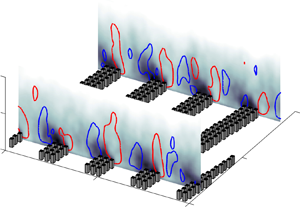Article contents
Flow-roughness heterogeneity: critical obliquity and salient parameters
Published online by Cambridge University Press: 23 February 2021
Abstract

A uniform distribution of roughness elements of height,  $h$, enhances turbulent momentum exchanges in wall flows of thickness,
$h$, enhances turbulent momentum exchanges in wall flows of thickness,  $\delta$. For
$\delta$. For  $\delta/h$ above a nominal threshold, this distribution of elements enhances drag, but does not induce structural response to outer-/inertial-layer turbulence. Large-scale spatial variability in element attributes, however, can induce
$\delta/h$ above a nominal threshold, this distribution of elements enhances drag, but does not induce structural response to outer-/inertial-layer turbulence. Large-scale spatial variability in element attributes, however, can induce  $\delta$-scale response in the instantaneous and Reynolds-averaged flow. For the case of a large-scale heterogeneity aligned orthogonal and parallel to the primary transport direction, the Reynolds-averaged flow responds with formation of an internal boundary layer (IBL) and counter-rotating secondary cells, respectively. For oblique flow-heterogeneity alignments, Anderson (J. Fluid Mech., vol. 886, 2020, p. A15), showed that IBL formation persists for flow-heterogeneity aligned at a series of oblique angles, before abruptly collapsing and transitioning to counter-rotating secondary cells at a critical obliquity. We define flow-roughness obliquity angle with symbol,
$\delta$-scale response in the instantaneous and Reynolds-averaged flow. For the case of a large-scale heterogeneity aligned orthogonal and parallel to the primary transport direction, the Reynolds-averaged flow responds with formation of an internal boundary layer (IBL) and counter-rotating secondary cells, respectively. For oblique flow-heterogeneity alignments, Anderson (J. Fluid Mech., vol. 886, 2020, p. A15), showed that IBL formation persists for flow-heterogeneity aligned at a series of oblique angles, before abruptly collapsing and transitioning to counter-rotating secondary cells at a critical obliquity. We define flow-roughness obliquity angle with symbol,  $\theta$, where
$\theta$, where  $\theta = 0$ and
$\theta = 0$ and  ${\rm \pi}/2$ corresponds with streamwise and spanwise heterogeneity, respectively, while the critical obliquity angle is denoted by
${\rm \pi}/2$ corresponds with streamwise and spanwise heterogeneity, respectively, while the critical obliquity angle is denoted by  $\theta_c$. We have used large-eddy simulation to perform a comprehensive parametric assessment on the effect of obliquity, element height, and spacing between adjacent ‘rows’ of elements, all of which is intended to identify the aforementioned critical obliquity. We once again report the aforementioned IBL persistence. It is shown that this response is a product of successive element sheltering, which can be recorded via the element frontal area index: as obliquity angle increases, there is a critical obliquity at which downflow elements fall in the sheltering zone of upflow elements; we find that
$\theta_c$. We have used large-eddy simulation to perform a comprehensive parametric assessment on the effect of obliquity, element height, and spacing between adjacent ‘rows’ of elements, all of which is intended to identify the aforementioned critical obliquity. We once again report the aforementioned IBL persistence. It is shown that this response is a product of successive element sheltering, which can be recorded via the element frontal area index: as obliquity angle increases, there is a critical obliquity at which downflow elements fall in the sheltering zone of upflow elements; we find that  $\theta_c = 22 {\rm \pi}/ 56$.
$\theta_c = 22 {\rm \pi}/ 56$.
JFM classification
Information
- Type
- JFM Papers
- Information
- Copyright
- © The Author(s), 2021. Published by Cambridge University Press
References
REFERENCES
- 7
- Cited by


